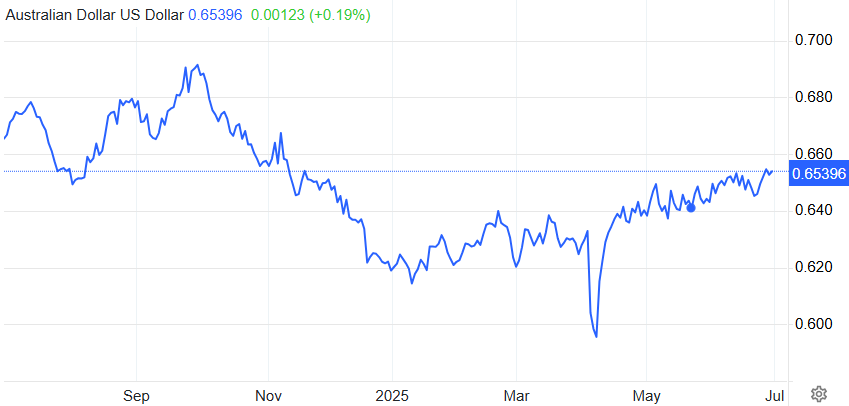Big opportunity but lots of risk - Morgan Stanley's take on markets
The old curse, “may you live in interesting times,” is being loudly felt in markets in 2025. The first six months of the year have seen markets whipsaw about, tossed around by escalating geopolitical concerns and by US policies (both expected or surprise tweets, depending on the day).
Even in the last two weeks alone, we’ve seen:
- The removal of the US ‘revenge tax’ on countries, like Australia, that have special services taxes on large US tech firms.
- The US confirm a trade deal framework with China, and walk away from discussions with Canada.
It’s worth highlighting that this is by no means a conclusive list of activity.
The S&P 500 enjoyed a rally late last week, closing at a record high, and the ASX 200 is tipped to enjoy the best returns it has seen since COVID-19. Not exactly a result we would have banked on mere months ago – nor should we bank on it in a few months ahead either.
As Head of Australian Macro Research for Morgan Stanley, Chris Nicol, explains, risks remain elevated and he will be monitoring both trade policies and labour market strength in the coming months.
“Our global economics team sees global growth slowing from around 3.5% last year, to 2.5% this year, just above the threshold for a global recession and with risks skewed to the downside,” he says, adding that softer Chinese and US growth will flow to Australia via trade and investment channels.
In this interview, he shared what he will be monitoring over the next six months, as well as highlighting the biggest opportunity he sees for Australian investors.
The market risks to watch and global outlook
Nicol is monitoring three key risks in markets in the coming months.
- Trade – the potential for a re-escalation of trade tensions in tariff negotiations, particularly from a US/European lens.
- Inflation – as tariff impost is transmitted across the US and potentially shared with other countries, there may be a re-acceleration of inflation pulse.
- Bond yields – the potential of a spike in bond yields triggered by fiscal sustainability concerns.
He highlights a slowdown in global growth and notes that the Australian mining and manufacturing sectors are exposed to this.
“We see this as more of a price than volume impact [for mining], but broader manufacturing is also likely to be impacted from a softer global backdrop and greater trade policy uncertainty,” he says.
This activity will also play out in the upcoming Australian earnings season in August.
“Resource-linked earnings have been downgraded, and Industrial outlooks have been cautious in light of a volatile global backdrop,” Nicol says, but explains it isn’t all bad news.
“We are hopeful that a trough in earnings can be found and watching for animal spirits linked to domestic policy settings. Any stability in global footings could set the stage for a broader rotation away from large cap bias in positioning.”
Honing in on domestic policy, Nicol is seeing plenty to scrutinise in the form of the pace of the monetary easing cycle and the emerging reform agenda surrounding tax and productivity from the Federal Government.
“How fast does the RBA find neutral and what animal spirits in the economy does that spark,” he muses, given markets are sensitive to pace and final outcomes.
There’s been plenty of media noise around government policy and investors (and therefore markets) respond to this.
“Government spending will be sustained but the way we pay for that is being brought into market view by this reform agenda,” he says.
The Australian dollar is largely capped on the upside
Nicols notes that the Australian dollar fully participated in the early April sell-off for risk assets, but believes that the current levels have formed a base against the US dollar and there may be some appreciation against the US dollar towards 70c by mid-next year.

“More importantly, however, we see less strength against other key crosses such as the Euro or Japanese yen as our global rates team sees both these currencies as strengthening against the US dollar this year.
This means that upside in the trade-weighted Australian dollar is capped at this juncture,” Nicol says.
While he sees some headwinds for currency and earnings translation in 2026, he views them as manageable, whilst current levels for the Australian dollar are positive for the economy.
“In our view, the levels we see for the Australian dollar keep the currency economically competitive,” he explains.
Positioning for the market and a big opportunity to watch
Morgan Stanley has invested its model portfolio based on four areas of focus outlined below.
- Respect the regional attraction of Australian resilience via a selection of large-cap holdings.
- Embrace rate-sensitive opportunity where it presents.
- Continue to hold a structural growth and a quality sleeve of stocks.
- Retain some Resource exposure as insurance optionality of global risk de-escalation and maintain some Gold exposure as an uncorrelated hedge.
Gold has been an obvious winner across the volatility of the start of the year, but prices pulled back more recently as investors saw the potential for more calm in markets – Nicol sees value in continuing to maintain a holding – we’re not in still waters yet after all (and even if we were, diversification is finance’s only free lunch after all).
Nicol points to the second focus as the biggest opportunity he sees for investors in the second half of the year.
“We are looking for exposure to cash rate sensitive sectors that can benefit from what we think will be a volume (rather than price) led recovery in Australian Housing and Construction,” he says.
The final word
With constant activity and media headlines globally hitting markets, Nicol shares that the best lesson of his career has been to “distil and dismiss.”
“In a world of noise and information that is only building in availability and velocity, learn to distil that torrent of content and be confident to dismiss what is not relevant to the investment decision at hand,” Nicols explains.
It’s a timely reminder at a point when a simple tweet can move markets.
Learn more
Information is everywhere; true insight is rare. Morgan Stanley brings knowledge and experience from across the globe to make sense of the issues that matter. Find more insights here.
2 topics


